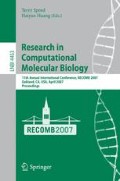Abstract
We describe an algorithm, IsoRank, for global alignment of two protein-protein interaction (PPI) networks. IsoRank aims to maximize the overall match between the two networks; in contrast, much of previous work has focused on the local alignment problem— identifying many possible alignments, each corresponding to a local region of similarity. IsoRank is guided by the intuition that a protein should be matched with a protein in the other network if and only if the neighbors of the two proteins can also be well matched. We encode this intuition as an eigenvalue problem, in a manner analogous to Google’s PageRank method. We use IsoRank to compute the first known global alignment between the S. cerevisiae and D. melanogaster PPI networks. The common subgraph has 1420 edges and describes conserved functional components between the two species. Comparisons of our results with those of a well-known algorithm for local network alignment indicate that the globally optimized alignment resolves ambiguity introduced by multiple local alignments. Finally, we interpret the results of global alignment to identify functional orthologs between yeast and fly; our functional ortholog prediction method is much simpler than a recently proposed approach and yet provides results that are more comprehensive.
Access this chapter
Tax calculation will be finalised at checkout
Purchases are for personal use only
Preview
Unable to display preview. Download preview PDF.
References
Bandyopadhyay, S., Sharan, R., Ideker, T.: Systematic identification of functional orthologs based on protein network comparison. Genome Res. 16(3), 428–435 (2006)
Breitkreutz, B.J., Stark, C., Tyers, M.: The GRID: the general repository for interaction datasets. Genome Biology 4(3), R23 (2003)
FlyBase Consortium: The FlyBase database of the drosophila genome projects and community literature. Nucleic Acids Res. 31(1), 172–175 (2003)
Kelley, B.P., et al.: Pathblast: a tool for alignment of protein interaction networks. Nucleic Acids Res. 32(Web Server issue), W83–88 (2004)
Xenarios, I., et al.: DIP, the database of interacting proteins: a research tool for studying cellular networks of protein interactions. Nucleic Acids Res. 30(1), 303–305 (2002)
Han, J.D., et al.: Evidence for dynamically organized modularity in the yeast protein-protein interaction network. Nature 430(6995), 88–93 (2004)
Miller, J.P., et al.: Large-scale identification of yeast integral membrane protein interactions. Proc. Natl. Acad. Sci. USA 102(34), 12123–12128 (2005)
Kellis, M., et al.: Methods in comparative genomics: genome correspondence, gene identification and regulatory motif discovery. J. of Computational Biology 11(2-3), 319–355 (2004)
Krogan, N.J., et al.: Global landscape of protein complexes in the yeast saccharomyces cerevisiae. Nature 440(7084), 637–643 (2006)
Uetz, P., et al.: A comprehensive analysis of protein-protein interactions in saccharomyces cerevisiae. Nature 403(6770), 623–627 (2000)
Pinter, R.Y., et al.: Alignment of metabolic pathways. Bioinformatics 21(16), 3401–3408 (2005)
Ito, T., et al.: A comprehensive two-hybrid analysis to explore the yeast protein interactome. Proc. Natl. Acad. Sci. USA 98(8), 4569–4574 (2001)
Flannick, J., Novak, A., Srinivasan, B.S., McAdams, H.H., Batzoglou, S.: Graemlin: general and robust alignment of multiple large interaction networks. Genome Res. 16(9), 1169–1181 (2006)
Golub, G.H., Van Loan, C.: Matrix computations. Johns Hopkins University Press, Baltimore (2006)
Gat-Viks, I., Tanay, A., Raijman, D., Shamir, R.: A probabilistic methodology for integrating knowledge and experiments on biological networks. J. of Computational Biology 13(2), 165–181 (2006)
Koyuturk, M., Grama, A., Szpankowski, W.: Pairwise local alignment of protein interaction networks guided by models of evolution. In: Proc. of the 9th International Conference on Research in Computational Molecular Biology (RECOMB) (2005)
Maslov, S., Sneppen, K.: Specificity and stability in topology of protein networks. Science 296(5569), 910–913 (2002)
Nabieva, E., Jim, K., Agarwal, A., Chazelle, B., Singh, M.: Whole-proteome prediction of protein function via graph-theoretic analysis of interaction maps. Bioinformatics 21(Suppl. 1), i302–310 (2005)
O’Brien, K.P., Remm, M., Sonnhammer, E.L.: Inparanoid: a comprehensive database of eukaryotic orthologs. Nucleic Acids Res. 33(Database issue), D476–480 (2005)
Papadimitriou, C., Steiglitz, K.: Combinatorial optimization: algorithms and complexity. Dover (1998)
Qi, Y., Klein-Seetharaman, J., Bar-Joseph, Z.: Random forest similarity for protein-protein interaction prediction from multiple sources. Proc. of the Pacific Symposium on Biocomputation (2005)
Singh, R., Xu, J., Berger, B.: Struct2net: Integrating structure into protein-protein interaction prediction. Proceedings of the Pacific Symposium on Biocomputation (2006)
Sontag, D., Singh, R., Berger, B.: Probabilistic modeling of systematic errors in yeast two-hybrid experiments. Proceedings of the Pacific Symposium on Biocomputation (to appear, 2007)
Srinivasan, B.S., Novak, A., Flannick, J., Batzoglou, S., McAdams, H.: Integrated protein interaction networks for 11 microbes. Proc of the 10th International Conference on Research in Computational Molecular Biology(RECOMB) (2006)
von Mering, C., et al.: Comparative assessment of large-scale data sets of protein-protein interactions. Nature 417(6887), 399–403 (2002)
Yao, M.Y., Lam, T.W., Ting, H.F.: An even faster and more unifying algorithm for comparing trees via unbalanced bipartite matchings. J. of Algorithms 40, 212 (2006)
Yeang, C.H., Vingron, M.: A joint model of regulatory and metabolic networks. BMC Bioinformatics 7, 332 (2006)
Yook, S.H., Oltvai, Z.N., Barabasi, A.L.: Functional and topological characterization of protein interaction networks. Proteomics 4(4), 928–942 (2004)
Author information
Authors and Affiliations
Editor information
Rights and permissions
Copyright information
© 2007 Springer Berlin Heidelberg
About this paper
Cite this paper
Singh, R., Xu, J., Berger, B. (2007). Pairwise Global Alignment of Protein Interaction Networks by Matching Neighborhood Topology. In: Speed, T., Huang, H. (eds) Research in Computational Molecular Biology. RECOMB 2007. Lecture Notes in Computer Science(), vol 4453. Springer, Berlin, Heidelberg. https://doi.org/10.1007/978-3-540-71681-5_2
Download citation
DOI: https://doi.org/10.1007/978-3-540-71681-5_2
Publisher Name: Springer, Berlin, Heidelberg
Print ISBN: 978-3-540-71680-8
Online ISBN: 978-3-540-71681-5
eBook Packages: Computer ScienceComputer Science (R0)

